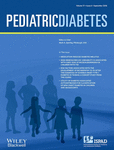Utility of diabetes-associated autoantibodies for classification of new onset diabetes in children and adolescents
Abstract
Objective
To determine whether measuring diabetes-associated autoantibodies (DAA) in pediatric new onset diabetes (NODM) can be restricted to patients with equivocal diabetes type.
Research design and methods
Retrospective analysis of all patients with NODM admitted to Boston Children's Hospital from 1 October 2007 to 1 July 2013 who had measurement of DAA [glutamic acid decarboxylase, insulin, insulinoma-associated antigen 2 (IA-2)]. Data collection included initial diagnosis of diabetes type before DAA results and at follow-up. We used logistic regression to predict type 1 diabetes (T1D) and developed a clinical score to classify diabetes type.
Results
Of 1089 patients (45.4% female, 76.7% White, age 10.6 ± 4.5 yr), initial diagnosis was 1021 (93.8%) T1D, 42 (3.9%) type 2 diabetes (T2D), and 26 (2.4%) other. Of 993 patients with clinical T1D, 78 (7.9%) were DAA−, and of 42 patients with clinical T2D, 12 (28.6%) were DAA+. Type of diabetes was reclassified at follow-up in less than 6% of patients. Data from a subset of 736 patients were used to develop a scoring system to predict T1D. Using weight z-score, age, and race, the scoring system had 91.7% sensitivity, 82% specificity, and a positive predictive value of 98.6%, and suggested DAA measurement was unnecessary in 85.3% of patients. Findings were similar in a validation cohort of 234 patients.
Conclusions
Application of a simple scoring system may reduce to ∼15% the number of DAA measurements needed to classify diabetes type, resulting in substantial cost savings. Clinical judgment should guide the decision to measure DAA.




